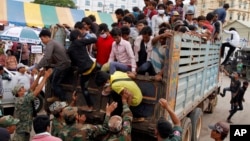In Cambodia, as credit becomes increasingly available, more people are taking loans from microfinance institutions to help with migration.
As of June 2015, microfinance institutions lent more than $2 billion, compared to $1.6 billion dollars in 2014, according to the Cambodia Microfinance Association.
Maryann Bylander, an assistant professor in sociology at Lewis and Clark College, says that people use microcredit in different ways in coordination with migration, though repayment is commonly made either through wage labor inside Cambodia or remittance from abroad.
“For some people, migration is already happening, and so they borrow and use that credit,” Bylander told VOA Khmer. “For other people, they’re indebted, and they can’t finance or they can’t repay their loan, and so they have to migrate.”
These scenarios greatly benefit the lenders, though not always the borrowers. “The fact that Cambodians are working in Thailand provides tremendous opportunity for the microfinance sector, because they have some regular source of income,” Bylander said. “Those wages are higher than in Cambodia.”
But this means vulnerability and risk for borrowers, because often jobs abroad can be unstable, and migrant workers can be cheated out of their salary, she said.
"We need a bit more regulation in terms of how vulnerability may be heightened by the debt of migrant workers," she said.
In its report on the impact of microfinance services in the country, the Cambodia Microfinance Association found that “MFIs are serving the poor,” creating more income and assets for microfinance clients.
But Bylander said that’s not always the case. “We know that debt heightens vulnerability for migrant workers,” she said. “Maybe we should really be stressing legal opportunities for migration.”







